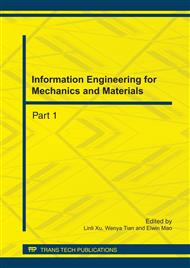p.284
p.288
p.294
p.298
p.302
p.307
p.313
p.317
p.322
Linear Location of Acoustic Emission Source Based on LS-SVR and NGA
Abstract:
To solve the fatigue damage location problem of helicopter moving component, a new approach for linear location of acoustic emission (AE) source based on least squares support vector machine for regression (LS-SVR) and niche genetic algorithm (NGA) was proposed. Several time domain parameters of AE signal were taken as the inputs, and the linear coordinates of the breakpoints as the output. The sharing function based niche genetic algorithm is used to select the LS-SVR parameters automatically. The results of pencil lead break location experiment on specimen of carbon fiber materials indicate that the proposed approach can implement linear location of AE source effectively, and has better performance on convergence rate and location accuracy than RBF and BP neural network.
Info:
Periodical:
Pages:
302-306
Citation:
Online since:
July 2011
Authors:
Price:
Сopyright:
© 2011 Trans Tech Publications Ltd. All Rights Reserved
Share:
Citation:


